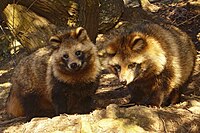Common raccoon dog
- This article deals with the wild animal; see tanuki for this animal in folklore and popular culture.
| Raccoon Dog | |
|---|---|

| |
| Two raccoon dogs | |
| Scientific classification | |
| Kingdom: | |
| Phylum: | |
| Class: | |
| Order: | |
| Family: | |
| Genus: | Nyctereutes Temminck, 1839
|
| Species: | N. procyonoides
|
| Binomial name | |
| Nyctereutes procyonoides (Gray, 1834)
| |
The Raccoon Dog (Nyctereutes procyonoides "nycto-" = Gr. "night," "ereutes" = Gr. "wanderer," "procyon" = "raccoon," "-oides" = Gr. "-oid") is a member of the dog family indigenous to east Asia. It is the only species in its genus Nyctereutes. It is named for its resemblance to the raccoon, to whom it is only distantly related (no more than any other dog). The animal is also known under the Japanese name tanuki (Katakana: タヌキ; Kanji: 狸 or in Kyujitai: 貍), where it carries historical and cultural significance.
Raccoon Dogs are native to Japan, southeastern Siberia, and Manchuria but now range as far as Scandinavia and France; in 2005, sightings were reported in Italy as well. Average adult head and body length is about 65 cm (2 ft) and weight ranges from 4 to 10 kg (9 to 22 lb). Average litters consist of 5 pups. Longevity is 3–4 years in the wild and 11 years in captivity. They are found in both plains and mountainous regions and are especially common in woodlands. Raccoon Dogs are commonly seen near villages and in rural areas.
Like many other canines, they are omnivorous. However, their diets are atypically diverse, consisting of invertebrates, frogs, lizards, rodents and birds along with seeds and berries. Those living near the ocean will also eat crabs and scavenged marine life. In cold season they hibernate, having fattened themselves during the autumn, not unlike bears.
Raccoon Dog populations have declined in recent years due to hunting, urbanization, an increase of animals associated with human civilization such as pets and abandoned animals, and diseases that may be transmitted between them. They are also killed for their fur in China.
Raccoon Dogs are secretive and not very aggressive; they prefer to hide or scream rather than fight. They are monogamous; some fights occur between males for the females. Mating season begins when the tanuki emerge from their burrows. The female is in heat for about six days. The baculum tie in coitus lasts about six minutes, shorter than other canids. When the cubs are born after a gestation of about 60 days, the male will assist in cub-rearing, first by providing food to his mate and then also for the cubs when they are weaned, about 50 days after birth. The young are physically and sexually mature after one year.
The Raccoon Dog is a unique member of the canid family as it is the only member to go into torpor through the winter months and is also known to "play dead" when attacked. They do not bark, and they turn their tail into an inverted U to express dominance. The brain of the tanuki is poorly developed compared to dogs and wolves, and its teeth are small. Its testicles are notably large, which figure into Japanese folklore.
There is some debate in the scientific community at present regarding speciation between the Siberian (N. p. ussuriensis) and Chinese subspecies (N. p. procyonoides) and the Japanese Raccoon Dog subspecies (N. p. viverrinus) in that due to chromosome[1], behavioral and weight differences, the Japanese Raccoon Dog should be considered a separate species from the two other subspecies.
References
- Template:IUCN2006 Database entry includes justification for why this species is of least concern
- "Nyctereutes procyonoides". Integrated Taxonomic Information System. 23 March.
{{cite web}}: Check date values in:|date=and|year=/|date=mismatch (help)
External links
- World Conservation Union - article on raccoon dogs
- America Zoo - basic info, one image
- Lioncrusher's Domain - detailed information, image
- canids.org - technical and conservation information
- Lauri Sippu's page - many images
- Skulls unlimited - raccoon dog skull image, purchase
- BBC - very basic information with images
- Animal Planet - basic information, image
- Foundation TV's "Brilliant Creatures" - a pair of on-camera raccoon dogs
- Nyctereutes abdeslami - information on another extinct species of its genus
